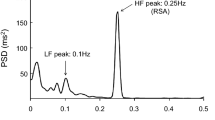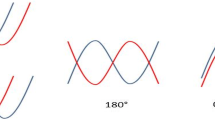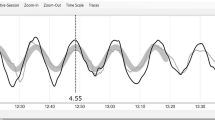Abstract
This study describes the use of a biofeedback method for the noninvasive study of baroreflex mechanisms. Five previously untrained healthy male participants learned to control oscillations in heart rate using biofeedback training to modify their heart rate variability at specific frequencies. They were instructed to match computer-generated sinusoidal oscillations with oscillations in heart rate at seven frequencies within the range of 0.01–0.14 Hz. All participants successfully produced high-amplitude target-frequency oscillations in both heart rate and blood pressure. Stable and predictable transfer functions between heart rate and blood pressure were obtained in all participants. The highest oscillation amplitudes were produced in the range of 0.055–0.11 Hz for heart rate and 0.02–0.055 Hz for blood pressure. Transfer functions were calculated among sinusoidal oscillations in the target stimuli, heart rate, blood pressure, and respiration for frequencies at which subjects received training. High and low target-frequency oscillation amplitudes at specific frequencies could be explained by resonance among various oscillatory processes in the cardiovascular system. The exact resonant frequencies differed among individuals. Changes in heart rate oscillations could not be completely explained by changes in breathing. The biofeedback method also allowed us to quantity characteristics of inertia, delay, and speed sensitivity in baroreflex system. We discuss the implications of these findings for using heart rate variability biofeedback as an aid in diagnosing various autonomic and cardiovascular system disorders and as a method for treating these disorders.
Similar content being viewed by others
REFERENCES
Akselrod, S. (1988). Spectral analysis of fluctuations in cardio-vascular parameters: Quantitative tool for the investigation of autonomic control. Trends in Pharmacological Science, 9, 6–9.
Akselrod, S., Gordon, D., Madwed, J. B., Snidman, N. C., Shannon, D. C., & Cohen, R. J. (1985). Hemodynamic regulation: Investigation by spectral analysis. American Journal of Physiology, 249 (Heart and Circulatory Physiology, 18), H867–H875.
Badra, L. J., Cooke, W. H., Hoag, J. B., Crossman, A. A., Kuusela, T. A., Tahvanainen, K. U. O., & Eckberg, D. L. (2001). Respiratory modulation of human autonomic rhythms. American Journal of Physiology (Heart and Circulatory Physiology), 280, H2674–H2688.
Berger, R. D., Saul, J. P., & Cohen, R. J. (1989). Transfer function analysis of autonomic regulation. 1. Canine a trial rate response. American Journal of Physiology, 256 (Heart and Circulatory Physiology, 25), H142–H152.
Bernardi, L., Leuzzi, S., Radaelli, A., Passino, C., Johnston, J. A., & Sleight, P. (1994). Low frequency spontaneous fluctuations of R-R interval and blood pressure in conscious humans: A baroreceptor or central phenomenon? Clinical Science, 87, 649–654.
Bernardi, L., Rossi, M., Leuzzi, S., Mevio, E., Fornasari, G., Calciati, A., et al. (1997). Reduction of 0.1 Hz microcirculatory fluctuations as evidence of sympathetic dysfunction in insulin-dependent diabetes. Cardiovascular Research, 34, 185–191.
Berntson, G. G., Bigger, J. T., Jr., Eckberg, D. L., Grossman, P., Kaufmann, P. G., Malik, M., et al. (1997). Heart rate variability: Origins, methods, and interpretive caveats. Psychophysiology, 34, 623–648.
Brown, T. E., Beinghtol, L. A., Koh, J., & Eckberg, D. L. (1993). Important influence of respiration on human R-R interval power spectra is largely ignored. Journal of Applied Physiology, 75, 2310–2317.
Chernigovskaya, N. V., Vaschillo, E. G., Petrash, V. V., & Rusanovsky, V. V. (1990). Voluntary regulation of the heart rate as a method of functional condition correction in neurotics. Human Physiology, 16, 58–64.
Clynes, M. (1960). Respiratory sinus arrhythmia: Laws derived from computer simulation. Journal of Applied Physiology, 15, 863–874.
Cooke, W. H., Ames IY, J. E., Crossman, A. A., Cox, J. P., Kuusela, T. A., Tahvanainen, K. U. O., et al. (2000). Nine months in space: Effects on human autonomic cardiovascular regulation. Journal of Applied Physiology, 89(3), 1039–1050.
Cooke, W. H., Cox, J. P., Diedrich, A. M., Taylor, J. A., Beightol, L. A., Ames IY, J. E., et al. (1998). Controlled breathing protocols probe human autonomic cardiovascular rhythms. American Journal of Physiology, 274, H709–H718.
DeBoer, R. W., Karemaker, J. M., & Strackee, J. (1987). Hemodynamic fluctuations and baroreflex sensitivity in Humans: A beat-to-beat model. American Journal of Physiology, 253 (Heart and Circulatory Physiology, 22), H680–H689.
Eckberg, D. L., & Eckberg, M. J. (1982). Human sinus node responses to repetitive, ramped carotid baroreceptor stimuli. American Journal of Physiology, 242 (Heart and Circulatory Physiology, 11), H638–H644.
Eckberg, D. L., & Sleight, P. (1992). Human baroreflexes in health and disease. Oxford: Clarendon Press.
Eykhoff, P. (1974). System identification: Parameter and state estimation (p. 684). New York: Wiley-Interscience.
Gevirtz, R. (1999). Resonance frequency training to restore autonomic homeostasis for treatment of psychophysiological disorders. Biofeedback, 4, 7–9.
Giardino, N., Lehrer, P. M., & Feldman, J. (2000). The role of oscillations in self-regulation: Their contribution to homeostatis. In D. Kenney & F. J. McGuigan (Eds.), Stress and health: Research and clinical applications (pp. 27–52). Amsterdam: Harwood.
Grodins, F. S. (1963). Control theory and biological systems (255 pp.) NewYork and London: Columbia University Press.
Herbs, D., Gevirtz, R. N., & Jacobs, D. (1993). The effect of heart rate pattern biofeedback for the treatment of essential hypertension. First prize research paper at the 19th Biofeedback Society of California (November) meeting and Citation Poster at the 25th annual meeting of the Association for Applied Psychophysiology and Biofeedback, Atlanta, GA.
Kirchheim, H. R. (1976). Systemic arterial baroreceptor reflexes. Physiology Reviews, 56, 100–176.
Lehrer, P. M., Carr, R. E., Smetankine, A., Vaschillo, E. G., Peper, E., Porges, S., et al. (1997). Comparison of respiratory sinus arrhythmia and neck/trapezius EMG biofeedback for asthma: A pilot study. Applied Psychophysiology and Biofeedback, 22, 95–109.
Lehrer, P. M., Sasaki, Y., & Saito, Y. (1999). Zazen and cardiac variability. Psychosomatic Medicine, 61, 812–821.
Lehrer, P., Smetankin, A., & Potapova, T. (2000). Respiratory sinus arrhythmia biofeedback therapy for asthma: A report of 20 unmedicated pediatric cases using the Smetankin method. Applied Psychophysiology and Biofeedback, 25, 193–200.
Lehrer, P. M., Vaschillo, E., & Vaschillo, B. (2000). Resonant frequency biofeedback training to increase cardiac variability: Rationale and manual for training. Applied Psychophysiology and Biofeedback, 25, 181–192.
Malkin, V. B., & Gora, E. P. (1996). The participation of the respiration in the rhythmic interactions in the body. Success in Physiological Science, 27, 61–77.
Murphy, G. J. (1957). Basic automatic control theory. Princeton, NJ: Van Nostrand.
Penaz, J. (1992). Criteria for set point estimation in the volume clamp method of blood pressure measurement. Physiology Research, 41, 5–10.
Saul, J. P., Berger, R. D., Albrecht, P., Stein, S. H., Chen, M. H., & Cohen, R. J. (1991). Transfer function analysis of the circulation: Unique insights into cardiovascular regulation. American Journal of Physiology, 261 (Heart and Circulatory Physiology, 30), H1231–H1245.
Shusterman, V., Anderson, K. P., & Barnea, O. (1997). Spontaneous skin temperature oscillations in normal human subjects. American Journal of Physiology, 273, R1173–R1181.
Sleight, P., La Rovere, M. T., Mortara, A., Pinna, G., Maestri, R., Leuzzi, S., et al. (1995). Physiology and pathophysiology of heart rate and blood pressure variability in humans: Is power spectral analysis largely an index of baroreflex gain? Clinical Science, 88, 103–109.
Steptoe, A., & Sawada, Y. (1989). Assessment of baroreceptor reflex function during mental stress and relaxation. Psychophysiology, 26, 140–147.
Task Force of the European Society of Cardiology and the North American Society of Racing and Electrophysiolog. (1996). Heart rate variability. Standards of measurement, physiological interpretation, and clinical use. Circulation, 93, 1043–1065.
Taylor, J. A., & Eckberg, D. L. (1996). Fundamental relations between short-term RR interval and arterial pressure oscillations in humans. Circulation, 93, 1527–1532.
Vaschillo, E. G. (1984). Dynamics of slow-wave cardiac rhythm structure as an index of functional state of an operant (p. 230). Doctoral dissertation. Saint Petersburg, Russia: Institute of Experimental Medicine.
Vaschillo, E. G., Zingerman, A. M., Konstantinov, M. A., & Menitsky, D. N. (1983). Research of the resonance characteristics for cardiovascular system. Human Physiology, 9, 257–265.
Wichterle, D., Melenovsky, V., Simek, J., Nekasova, L., Kautzner, J., & Malik, M. (2000). Cross-spectral analysis of heart rate and blood pressure modulations. Pace-Pacing and Clinical Electrophysiology, 23(9), 1425–1430.
Zingerman, A. M., Konstantinov, M. A., Menitsky, D. N., Logvinov, V. S., & Vaschillo, E. G. (1988). Entropystatistical, spectral, conditionally-stochastic and determined characteristics of heart rate under different functional conditions of a person. Success in Physiological Science, 19, 40–55.
Author information
Authors and Affiliations
Corresponding author
Rights and permissions
About this article
Cite this article
Vaschillo, E., Lehrer, P., Rishe, N. et al. Heart Rate Variability Biofeedback as a Method for Assessing Baroreflex Function: A Preliminary Study of Resonance in the Cardiovascular System. Appl Psychophysiol Biofeedback 27, 1–27 (2002). https://doi.org/10.1023/A:1014587304314
Issue Date:
DOI: https://doi.org/10.1023/A:1014587304314




